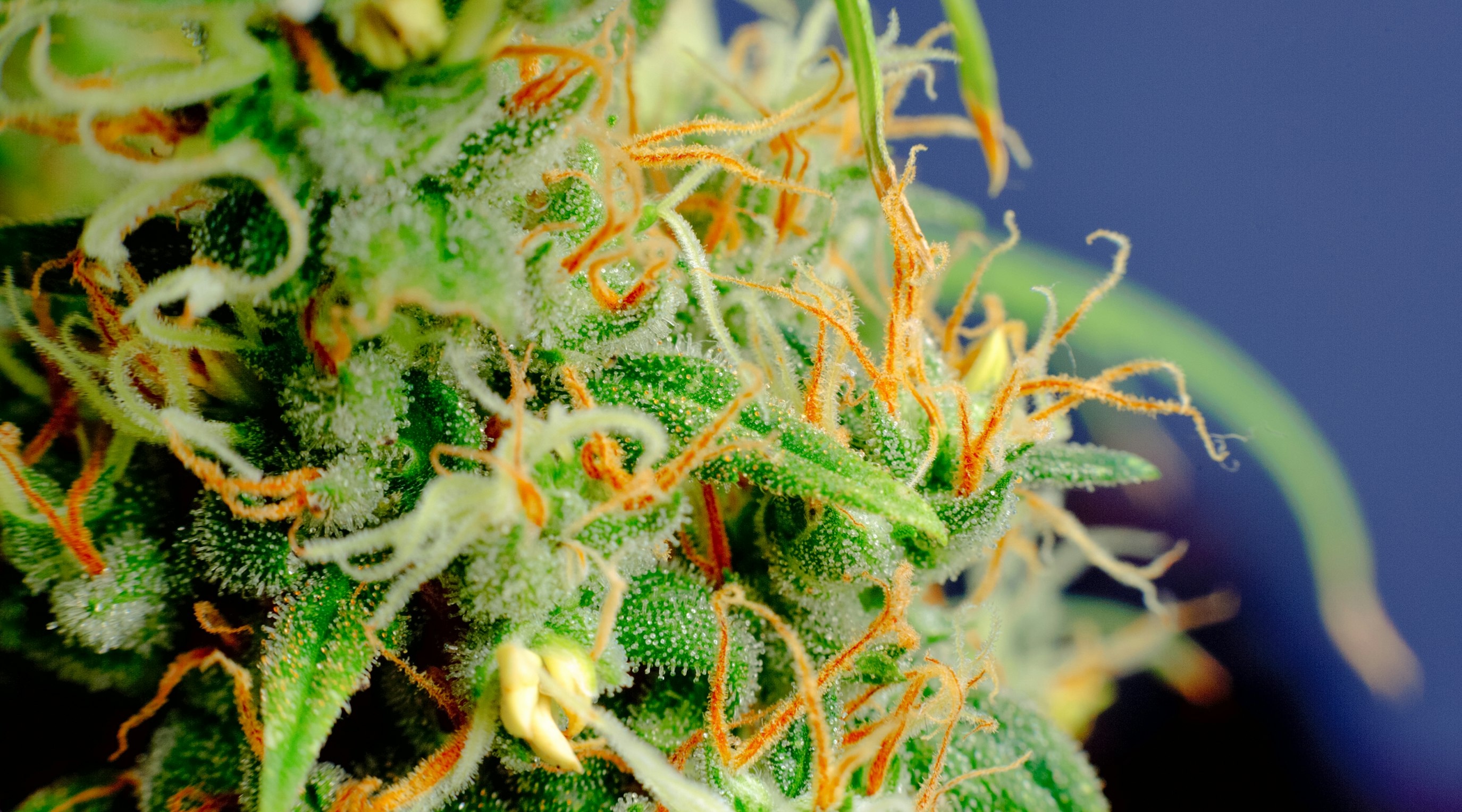Exploring the anatomy of the cannabis flower
8 min read
Lucy MacKinnon
Due to their high cannabinoid content, cannabis flowers, more colloquially known as ‘buds’, have been used throughout history to treat a number of health conditions or medical concerns, as well as for recreational or intoxicating purposes.
Not only do cannabis flowers, or buds, come in a variety of species or strains which evoke a range of effects, but they can also offer a range of potential medicinal benefits. Cannabis flowers can be ground up into granulates to be vaped, or the THC and CBD cannabinoids they contain can be extracted to be used as an ingredient in edibles or medications.
Contents
In the UK, medical cannabis was legalised for medicinal purposes in November 2018, however, many Brits are unaware that this includes medical cannabis flowers. To rectify this, and answer any questions you may have, we’ve put together this piece to explore the anatomy and the effects of cannabis flowers.
What is cannabis flower?
Unlike most other plants, the flowers of cannabis are famous for their substance content as opposed to their appearance. Flower production begins once the vegetative stage of growth finishes up (anywhere between 3 weeks to 4 months after the seed sprouts), with the largest flower typically found on female cannabis plants in a cluster, or a cola, at its highest point. Flowers are also produced on the branches, but in smaller sizes than the main cola.
Much like us, cannabis flowers, or buds, have their own intricate anatomy. The pistil, calyx, bracts, stigma, and trichomes can all be found within a single flower. In the case of medical cannabis, the bracts and trichomes are extremely important; bracts contain the plant's highest number of cannabinoids in their resin glands, and trichomes secrete high amounts of terpenes as well as CBD and THC in their ‘inactive’ forms.
The trichomes are also responsible for the diamond-encrusted appearance of cannabis buds. They essentially look like thousands of tiny crystals covering the cannabis flower. The colours in cannabis buds are a display of their genetics, PH, chemical composition, and the environment in which they grew. Typically, brightly coloured flowers come from cannabis plants that are grown in tropical temperatures, such as Sativa strains, whilst those with a darker colour profile tend to have been produced in colder climates.
Originating from Central Asia, Cannabis Sativa plants have been used for millennia in alternative or folk medicines. Sativa effects are anecdotally associated with having mood-boosting, energising or stimulating effects on humans.
Sativa’s popular counterpart, Cannabis Indica, is, again anecdotally, attributed with opposing qualities. Indica plants are said to potentially offer relaxing or sedative effects when consumed.
Hybrid strains are a result of cross-breeding between Indica and Sativa strains. They can be grown in a variety of environments and can offer patients a range of potential effects depending on the traits they inherit from their ‘parent plants’. The advancements in cannabis cultivation have led to an explosion of different hybrid strains hitting the market.
How does cannabis flower affect humans?
Cannabis has shown promise in offering possible therapeutic and intoxicating effects on humans when its active chemical components are administered. The short-term effects of consuming cannabis flower can range from feelings of euphoria and relaxation, to intensified hunger and impaired memory. These sensations are believed to be caused by cannabinoids, and intensified in the presence of terpenes and flavonoids, during what researchers call ‘the entourage effect’.
Cannabinoids, terpenes, and flavonoids are all housed in trichomes on the cannabis flower, with each group of compounds serving a different function. Over 150 different cannabis terpenes have been discovered, and they are known to be responsible for the plant's aroma, whilst flavonoids contribute towards the flavour and pigmentation of their buds.
THC and CBD exist in much higher concentrations than the other 100+ cannabinoids that have been identified in the cannabis plant, meaning the majority of cannabis’ associated effects have been attributed to these two compounds. As the primary psychoactive agent in cannabis, THC is believed to be responsible for the euphoric, elevating experiences of cannabis consumption, but has also been attributed to paranoia or increased anxiety when administered in high doses.
Because CBD is a non-intoxicating compound, it is not typically associated with the ‘high’ of cannabis and has been shown to possibly offer neuroprotective qualities. After administration, CBD has been seen to potentially decrease anxiety and pain levels, and in some cases, CBD has also been shown to counteract, or oppose, the effects or experiences induced by THC. The experiences and effects of THC and CBD are both dose-dependent, and it is always advisable for medical cannabis patients to speak to their clinicians to avoid adverse effects.
For cannabis to induce these effects, its cannabinoid content needs to be activated through the process of decarboxylation. This happens when heat is applied. For example, when cannabis flower is smoked, upon ignition THCa and CBDa are converted into their non-acidic form, THC and CBD. It is only once this conversion happens that a wide range of possible effects are introduced.
Vaporizers are able to heat them at a lower temperature, allowing the cannabinoids to activate and release into vapour for patients to inhale.
Much like cannabinoids, terpenes also undergo decarboxylation in the presence of heat, however their boiling points are reached at a much lower temperature. For this reason, vaping medical cannabis, as opposed to smoking it, promotes the likelihood of ‘the entourage effect’.
The entourage effect is a theory that relates to the collaboration of cannabinoids, terpenes, and flavonoids. It is believed these cannabis components work synergistically to produce a rounded, well-balanced experience by enhancing the individual qualities and the associated effects of each compound. The entire range of cannabis compounds are available in cannabis flowers, as well as in full spectrum or whole plant cannabis products.
What long-term effects can cannabis flower have?
Like many other kinds of prescription medication, there are some concerning risks associated with long-term usage of cannabis.
It was found that recreational cannabis users who had started consuming cannabis before the age of 16 didn’t perform as well as those who had started using cannabis later in life, during behavioural and cognitive exams that focused on attention, memory, and judgement.
Although, when the same tests were conducted repeatedly on medical cannabis patients, this group demonstrated better cognitive performance after consuming cannabis, than they had before. This could suggest the negative impact on cognitive function is more likely to be caused by the recreational use of cannabis, as opposed to medicinal cannabis applications.
Other recorded long-term effects can be the associated with the way cannabis is administered. Like cigarette smokers, users who smoke cannabis have shown signs of impaired lung function, and repeated, long-term recreational use has been associated with addiction. At high doses, cannabis has also been seen to possibly induce or promote psychosis, but it is believed individual genetics also influence the relationship between cannabis and the likelihood of developing a psychotic disorder. The evidence to support this claim is slightly dubious, but it is still worthy of mention.
Although the possible long-term effects of medical cannabis are concerning, this is something that is also seen throughout the pharmaceutical industry. Much like in the case of cannabinoids, the abuse of certain pharmaceutical drugs such as painkillers and antidepressants is linked with increased instances of dependence or negative impacts on mental health. In other instances, medical cannabis can sometimes be favoured by patients over conventionally prescribed medications like opiates due to its proven safety and efficacy.
As health is specific to each individual, it is crucial for medical cannabis patients to discuss these effects and experiences with their own doctor to seek personalised, professional guidance.
Medicinal applications of cannabis flower
The potential medicinal applications of cannabis flower have been recorded throughout history, and an expansion into the research and applications of this particular form of medical cannabis can be observed.
Medical cannabis has shown promise in being beneficial in the treatment of a number of neurological disorders, including rare forms of epilepsy, multiple sclerosis and Alzheimer's Disease due to its possible anti-epileptic, anti-inflammatory, and spasticity-reducing tendencies, respectively.
Patients experiencing anxiety and other psychological disorders have also been shown to respond positively to medical cannabis treatments in multiple studies. Low doses of THC are believed to have the potential to promote or increase the production of ‘happy hormones’ serotonin and dopamine. High levels of THC have demonstrated the potential to increase the level of deep sleep experienced by PTSD patients, which may lead to a reduction in traumatic nightmares.
Certain physiological conditions, such as those associated with chronic pain, have also demonstrated possible positive results when being treated with medicinal cannabis in a number of different studies, as have gastrointestinal disorders like irritable bowel syndrome (IBS) and inflammatory bowel disease (IBD).
Conclusion
As some areas require further investigation, it is important that cannabis is not branded as a ‘miracle’ drug. Instead, medical cannabis should be viewed as a treatment option that may be incredibly versatile, due to the known behaviours and interactions of its chemical constituents within the body's endocannabinoid system.
If you are considering journeying down the medicinal cannabis route, your first stop must be with a doctor that has experience in, and is registered to prescribe medicinal cannabis. Their are many factors that can affect how your body and mind reacts to medicinal cannabis, so always seek out professional advice before adding cannabis to your current treatment plan.
Releaf understands the importance of medical cannabis in treating various medical conditions. With our tailored monthly packages, specialist consultations for medical cannabis, and a unique medical cannabis card for protection, you can access the treatment you need without worrying about the stigma.
Share article
Did you like this article?
It is important to seek medical advice before starting any new treatments. The patient advisors at Releaf are available to provide expert advice and support. Alternatively, click here to book a consultation with one of our specialist doctors.
Elevate your wellness with medical cannabis
Get comprehensive care, convenience, and confidence with an all-in-one treatment plan.
Am I eligible?Authors
With five years of journalism and healthcare content creation under her belt, Lucy strives to improve medical cannabis awareness and access in the UK by producing high quality, credible content.
Editorial Policy
All of our articles are written by medical cannabis experts, guided by strict sourcing guidelines, and reference peer-reviewed studies and credible academic research. Our expert clinical team and compliance specialists provide valuable insights to ensure accuracy when required. Learn more in our editorial policy.
Need more help?










